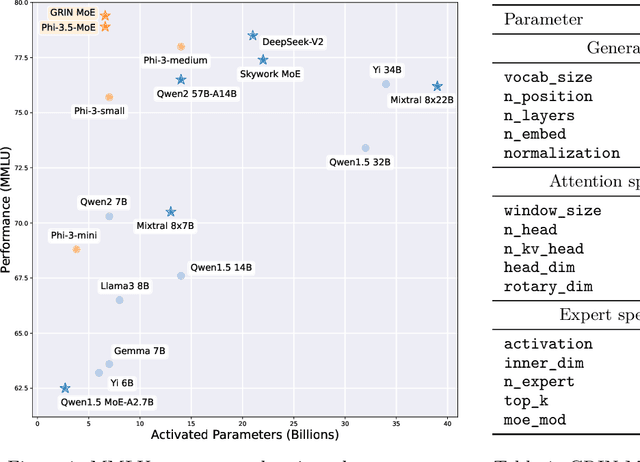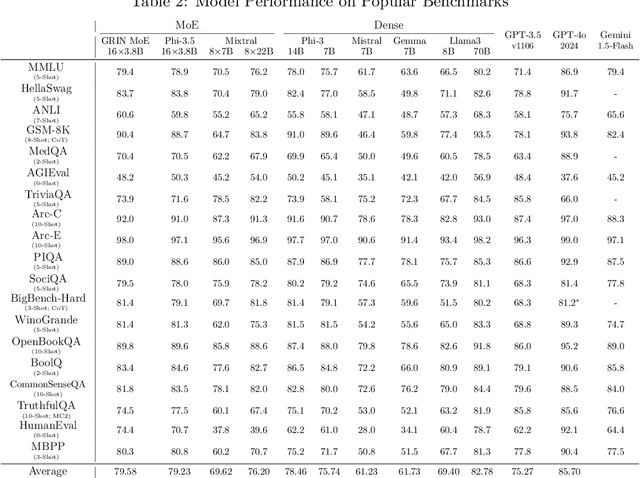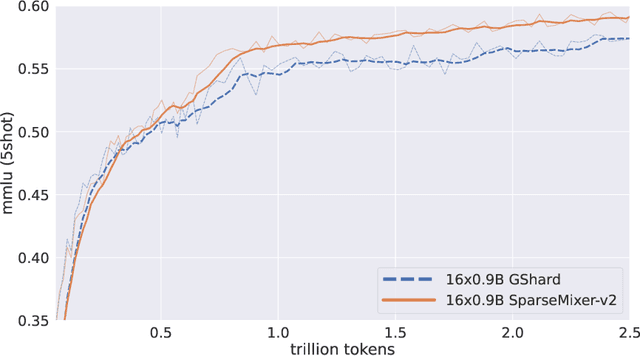Jilong Xue
Elk: Exploring the Efficiency of Inter-core Connected AI Chips with Deep Learning Compiler Techniques
Jul 15, 2025Abstract:To meet the increasing demand of deep learning (DL) models, AI chips are employing both off-chip memory (e.g., HBM) and high-bandwidth low-latency interconnect for direct inter-core data exchange. However, it is not easy to explore the efficiency of these inter-core connected AI (ICCA) chips, due to a fundamental tussle among compute (per-core execution), communication (inter-core data exchange), and I/O (off-chip data access). In this paper, we develop Elk, a DL compiler framework to maximize the efficiency of ICCA chips by jointly trading off all the three performance factors discussed above. Elk structures these performance factors into configurable parameters and forms a global trade-off space in the DL compiler. To systematically explore this space and maximize overall efficiency, Elk employs a new inductive operator scheduling policy and a cost-aware on-chip memory allocation algorithm. It generates globally optimized execution plans that best overlap off-chip data loading and on-chip execution. To examine the efficiency of Elk, we build a full-fledged emulator based on a real ICCA chip IPU-POD4, and an ICCA chip simulator for sensitivity analysis with different interconnect network topologies. Elk achieves 94% of the ideal roofline performance of ICCA chips on average, showing the benefits of supporting large DL models on ICCA chips. We also show Elk's capability of enabling architecture design space exploration for new ICCA chip development.
* This paper is accepted at the 58th IEEE/ACM International Symposium on Microarchitecture (MICRO'25)
MoE-CAP: Benchmarking Cost, Accuracy and Performance of Sparse Mixture-of-Experts Systems
May 16, 2025Abstract:The sparse Mixture-of-Experts (MoE) architecture is increasingly favored for scaling Large Language Models (LLMs) efficiently, but it depends on heterogeneous compute and memory resources. These factors jointly affect system Cost, Accuracy, and Performance (CAP), making trade-offs inevitable. Existing benchmarks often fail to capture these trade-offs accurately, complicating practical deployment decisions. To address this, we introduce MoE-CAP, a benchmark specifically designed for MoE systems. Our analysis reveals that achieving an optimal balance across CAP is difficult with current hardware; MoE systems typically optimize two of the three dimensions at the expense of the third-a dynamic we term the MoE-CAP trade-off. To visualize this, we propose the CAP Radar Diagram. We further introduce sparsity-aware performance metrics-Sparse Memory Bandwidth Utilization (S-MBU) and Sparse Model FLOPS Utilization (S-MFU)-to enable accurate performance benchmarking of MoE systems across diverse hardware platforms and deployment scenarios.
TileLang: A Composable Tiled Programming Model for AI Systems
Apr 24, 2025Abstract:Modern AI workloads rely heavily on optimized computing kernels for both training and inference. These AI kernels follow well-defined data-flow patterns, such as moving tiles between DRAM and SRAM and performing a sequence of computations on those tiles. However, writing high-performance kernels remains complex despite the clarity of these patterns. Achieving peak performance requires careful, hardware-centric optimizations to fully leverage modern accelerators. While domain-specific compilers attempt to reduce the burden of writing high-performance kernels, they often struggle with usability and expressiveness gaps. In this paper, we present TileLang, a generalized tiled programming model for more efficient AI Kernel programming. TileLang decouples scheduling space (thread binding, layout, tensorize and pipeline) from dataflow, and encapsulated them as a set of customization annotations and primitives. This approach allows users to focus on the kernel's data-flow itself, while leaving most other optimizations to compilers. We conduct comprehensive experiments on commonly-used devices, across numerous experiments, our evaluation shows that TileLang can achieve state-of-the-art performance in key kernels, demonstrating that its unified block-and-thread paradigm and transparent scheduling capabilities deliver both the power and flexibility demanded by modern AI system development.
AttentionEngine: A Versatile Framework for Efficient Attention Mechanisms on Diverse Hardware Platforms
Feb 21, 2025Abstract:Transformers and large language models (LLMs) have revolutionized machine learning, with attention mechanisms at the core of their success. As the landscape of attention variants expands, so too do the challenges of optimizing their performance, particularly across different hardware platforms. Current optimization strategies are often narrowly focused, requiring extensive manual intervention to accommodate changes in model configurations or hardware environments. In this paper, we introduce AttentionEngine, a comprehensive framework designed to streamline the optimization of attention mechanisms across heterogeneous hardware backends. By decomposing attention computation into modular operations with customizable components, AttentionEngine enables flexible adaptation to diverse algorithmic requirements. The framework further automates kernel optimization through a combination of programmable templates and a robust cross-platform scheduling strategy. Empirical results reveal performance gains of up to 10x on configurations beyond the reach of existing methods. AttentionEngine offers a scalable, efficient foundation for developing and deploying attention mechanisms with minimal manual tuning. Our code has been open-sourced and is available at https://github.com/microsoft/AttentionEngine.
WaferLLM: A Wafer-Scale LLM Inference System
Feb 06, 2025Abstract:Emerging AI accelerators increasingly adopt wafer-scale manufacturing technologies, integrating hundreds of thousands of AI cores in a mesh-based architecture with large distributed on-chip memory (tens of GB in total) and ultra-high on-chip memory bandwidth (tens of PB/s). However, current LLM inference systems, optimized for shared memory architectures like GPUs, fail to fully exploit these accelerators. We introduce WaferLLM, the first wafer-scale LLM inference system. WaferLLM is guided by a novel PLMR device model that captures the unique hardware characteristics of wafer-scale architectures. Leveraging this model, WaferLLM pioneers wafer-scale LLM parallelism, optimizing the utilization of hundreds of thousands of on-chip cores. It also introduces MeshGEMM and MeshGEMV, the first GEMM and GEMV implementations designed to scale effectively on wafer-scale accelerators. Evaluations show that WaferLLM achieves 200$\times$ better wafer-scale accelerator utilization than state-of-the-art systems. On a commodity wafer-scale accelerator, WaferLLM delivers 606$\times$ faster and 22$\times$ more energy-efficient GEMV compared to an advanced GPU. For LLMs, WaferLLM enables 39$\times$ faster decoding with 1.7$\times$ better energy efficiency. We anticipate these numbers will grow significantly as wafer-scale AI models, software, and hardware continue to mature.
MoE-CAP: Cost-Accuracy-Performance Benchmarking for Mixture-of-Experts Systems
Dec 10, 2024Abstract:The sparse Mixture-of-Experts (MoE) architecture is increasingly favored for scaling Large Language Models (LLMs) efficiently; however, MoE systems rely on heterogeneous compute and memory resources. These factors collectively influence the system's Cost, Accuracy, and Performance (CAP), creating a challenging trade-off. Current benchmarks often fail to provide precise estimates of these effects, complicating practical considerations for deploying MoE systems. To bridge this gap, we introduce MoE-CAP, a benchmark specifically designed to evaluate MoE systems. Our findings highlight the difficulty of achieving an optimal balance of cost, accuracy, and performance with existing hardware capabilities. MoE systems often necessitate compromises on one factor to optimize the other two, a dynamic we term the MoE-CAP trade-off. To identify the best trade-off, we propose novel performance evaluation metrics - Sparse Memory Bandwidth Utilization (S-MBU) and Sparse Model FLOPS Utilization (S-MFU) - and develop cost models that account for the heterogeneous compute and memory hardware integral to MoE systems. This benchmark is publicly available on HuggingFace: https://huggingface.co/spaces/sparse-generative-ai/open-moe-llm-leaderboard.
GRIN: GRadient-INformed MoE
Sep 18, 2024



Abstract:Mixture-of-Experts (MoE) models scale more effectively than dense models due to sparse computation through expert routing, selectively activating only a small subset of expert modules. However, sparse computation challenges traditional training practices, as discrete expert routing hinders standard backpropagation and thus gradient-based optimization, which are the cornerstone of deep learning. To better pursue the scaling power of MoE, we introduce GRIN (GRadient-INformed MoE training), which incorporates sparse gradient estimation for expert routing and configures model parallelism to avoid token dropping. Applying GRIN to autoregressive language modeling, we develop a top-2 16$\times$3.8B MoE model. Our model, with only 6.6B activated parameters, outperforms a 7B dense model and matches the performance of a 14B dense model trained on the same data. Extensive evaluations across diverse tasks demonstrate the potential of GRIN to significantly enhance MoE efficacy, achieving 79.4 on MMLU, 83.7 on HellaSwag, 74.4 on HumanEval, and 58.9 on MATH.
LUT Tensor Core: Lookup Table Enables Efficient Low-Bit LLM Inference Acceleration
Aug 12, 2024Abstract:As large language model (LLM) inference demands ever-greater resources, there is a rapid growing trend of using low-bit weights to shrink memory usage and boost inference efficiency. However, these low-bit LLMs introduce the need for mixed-precision matrix multiplication (mpGEMM), which is a crucial yet under-explored operation that involves multiplying lower-precision weights with higher-precision activations. Unfortunately, current hardware does not natively support mpGEMM, resulting in indirect and inefficient dequantization-based implementations. To address the mpGEMM requirements in low-bit LLMs, we explored the lookup table (LUT)-based approach for mpGEMM. However, a conventional LUT implementation falls short of its potential. To fully harness the power of LUT-based mpGEMM, we introduce LUT Tensor Core, a software-hardware co-design optimized for low-bit LLM inference. Specifically, we introduce software-based operator fusion and table symmetrization techniques to optimize table precompute and table storage, respectively. Then, LUT Tensor Core proposes the hardware design featuring an elongated tiling shape design to enhance table reuse and a bit-serial design to support various precision combinations in mpGEMM. Moreover, we design an end-to-end compilation stack with new instructions for LUT-based mpGEMM, enabling efficient LLM compilation and optimizations. The evaluation on low-bit LLMs (e.g., BitNet, LLAMA) shows that LUT Tensor Core achieves more than a magnitude of improvements on both compute density and energy efficiency.
Scaling Deep Learning Computation over the Inter-Core Connected Intelligence Processor
Aug 09, 2024Abstract:As AI chips incorporate numerous parallelized cores to scale deep learning (DL) computing, inter-core communication is enabled recently by employing high-bandwidth and low-latency interconnect links on the chip (e.g., Graphcore IPU). It allows each core to directly access the fast scratchpad memory in other cores, which enables new parallel computing paradigms. However, without proper support for the scalable inter-core connections in current DL compilers, it is hard for developers to exploit the benefits of this new architecture. We present T10, the first DL compiler to exploit the inter-core communication bandwidth and distributed on-chip memory on AI chips. To formulate the computation and communication patterns of tensor operators in this new architecture, T10 introduces a distributed tensor abstraction rTensor. T10 maps a DNN model to execution plans with a generalized compute-shift pattern, by partitioning DNN computation into sub-operators and mapping them to cores, so that the cores can exchange data following predictable patterns. T10 makes globally optimized trade-offs between on-chip memory consumption and inter-core communication overhead, selects the best execution plan from a vast optimization space, and alleviates unnecessary inter-core communications. Our evaluation with a real inter-core connected AI chip, the Graphcore IPU, shows up to 3.3$\times$ performance improvement, and scalability support for larger models, compared to state-of-the-art DL compilers and vendor libraries.
The Era of 1-bit LLMs: All Large Language Models are in 1.58 Bits
Feb 27, 2024Abstract:Recent research, such as BitNet, is paving the way for a new era of 1-bit Large Language Models (LLMs). In this work, we introduce a 1-bit LLM variant, namely BitNet b1.58, in which every single parameter (or weight) of the LLM is ternary {-1, 0, 1}. It matches the full-precision (i.e., FP16 or BF16) Transformer LLM with the same model size and training tokens in terms of both perplexity and end-task performance, while being significantly more cost-effective in terms of latency, memory, throughput, and energy consumption. More profoundly, the 1.58-bit LLM defines a new scaling law and recipe for training new generations of LLMs that are both high-performance and cost-effective. Furthermore, it enables a new computation paradigm and opens the door for designing specific hardware optimized for 1-bit LLMs.
 Add to Chrome
Add to Chrome Add to Firefox
Add to Firefox Add to Edge
Add to Edge